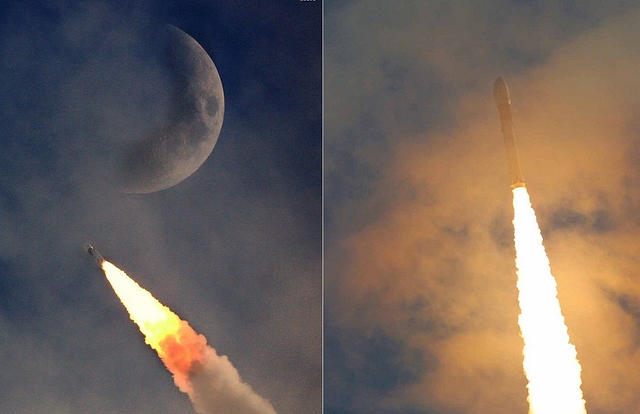
Why ISRO’s Latest Launch Was More Significant Than You Thought
The launch of GSAT-29 atop GSLV Mark-III looked similar to other satellite launches. But there are reasons why it was more significant than most such missions.
On Wednesday (14 November), the Indian Space Research Organisation (ISRO) successfully launched communication satellite GSAT-29 on the Geosynchronous Launch Vehicle (GSLV) Mark-III, which placed it into the Geosynchronous Transfer Orbit (GTO) – 36,000 kilometres from the Earth's surface in just 16 minutes after launch. The satellite, weighing 3,423 kilograms, will provide high-speed internet connectivity and improve telecommunication in remote areas of the country, specially Jammu and Kashmir and parts of north-eastern India, taking Prime Minister Narendra Modi’s ‘Digital India’ mission a step closer to success.
While the launch looked similar to other satellite launches undertaken by ISRO, there are reasons why it was more significant than most of those.
One, this satellite launch atop GSLV Mark-III was the second development flight of the vehicle. As the launch was successful, the vehicle, India’s heaviest, will be declared operational by the ISRO.
Although India has been a space-faring nation for more than 50 years, it has had to depend on others for the launch of its larger satellites to the GTO. Most recently, India used a heavy-duty rocket of Arianespace, world's first commercial launch service provider, for placing communication satellite GSAT-18 into the GTO. This is because India’s most capable launch vehicle until now, the GSLV Mark-II, is capable of launching payloads of only up to 2.2 tonnes into the geostationary orbit. However, the GSLV Mark-III will allow India to place satellites as heavy as 4-tonnes into the GTO. The maximum payload limit for the GSLV Mark-III is 60 per cent greater than that of the GSLV Mark-II.
Satellites in the GTO have advantages over those in other orbits. Satellites that are placed in the geosynchronous orbit, a high Earth orbit, move slower compared to satellites in the low Earth orbit (LEO) and the medium Earth orbit. This gives the satellites more time over any given area, allowing them to study the region in detail. Also, in the geosynchronous orbit, the time taken by a satellite to complete one revolution around the Earth is equal to the period of rotation of the earth on its axis. A satellite in this orbit moves at the same speed that the Earth is turning in. Therefore, the satellite seems to stay in place over a single longitude, though it may drift from north to south.
This allows a satellite in the geosynchronous orbit see a particular region of the planet almost all of the time, helping it track even the minutest developments in that area. This particular advantage, that satellites in the geosynchronous orbit enjoy, makes it attractive for both civilian and military use.
Apart from the launch of heavy satellites into the GTO, India plans to use GSLV-Mark-III for the launch of two critical missions – Chandrayaan-II, which involves soft landing on the lunar surface, and the human space flight mission, which the ISRO plans to undertake sometime before the 2022 deadline.
Moreover, the GSLV Mark-III is capable of lifting up to eight tonnes of payload to the LEO, enough to carry a manned module and establish a space station. The LEO is used for installations that space agencies are required to have frequent physical contact with, like space telescopes and space stations. Nearer the installation is to the surface of the Earth, easier it is to reach with space shuttles.
Two, the optical communication payload launched with the satellite will demonstrate data transmission at a very high rate through an optical communication link. According to NASA, optical communication can increase the rate of data transfer from satellites or far off spacecraft to Earth by 20 times.
Currently, it takes NASA’s Mars Reconnaissance Orbiter (MRO), which takes images using its High Resolution Imaging Science Experiment camera, nearly 7.5 hours to empty its on-board recorder and 1.5 hours to transfer a single image back to Earth (at the rate of 6 megabytes per second (mbps), the highest for any Mars mission). By using optical communication, which can have a speed of up to 100 mbps, the recorder on-board the MRO can be emptied in 26 minutes, and an image can be transferred to the Earth in less than 5 minutes.
Three, the satellite carries on-board a unique high-resolution camera, which will be put to test in orbit to carry out high resolution imaging. Among other things, such a camera can help the armed forces by closely tracking and photographing enemy forces, including deployment of warships.
And four, Q/V-band payload will be demonstrated for the first time. The Q/V bands (the word “band” refers to the radio frequencies used to and from the satellite) lie within the extremely high frequency (EHF) area of the radio spectrum. Experts believe that EHFs will improve the performance of high throughput satellites (a satellite that has many times the throughput of a traditional fixed-satellite service for the same amount of allocated frequency) by making possible the offloading of backhaul links (an expensive setup used to get data to a point from which it can be distributed over a network) between a satellite and its hubs from the Ka-band to the Q/V band. With this, more bandwidth can be made available for users and the number of hubs can be reduced. This, in turn, will help drive down the cost per bit.